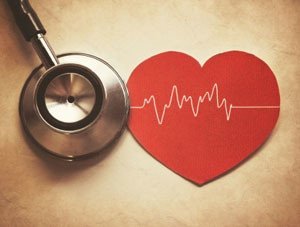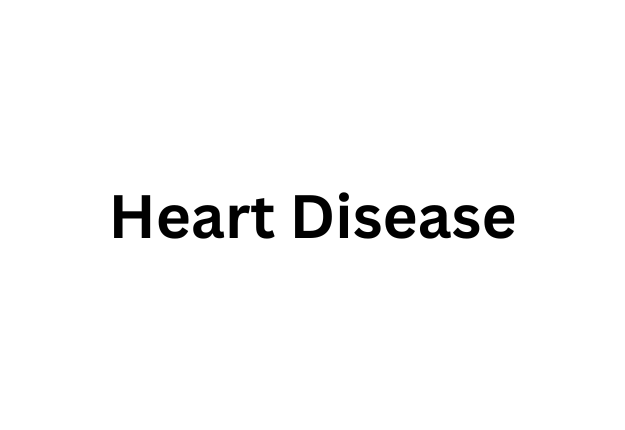What is Heart Disease?
Heart diseases encompass many conditions that involve the heart and its function.
The healthy heart
The heart is a muscular organ that functions as a pump. It has a right side (made of the right atrium and ventricle), which collects blood from the body and pumps it to the lungs for oxygenation and removal of carbon dioxide, and a left side (made of the left atrium and ventricle), which collects oxygenated blood from the lungs and pumps it throughout the body.
There are four valves (tricuspid, mitral, pulmonary, and aortic) in the heart that make sure blood flows in one direction, and prevent blood from flowing backwards.
Heartbeats occur in a continuous cycle of contraction (systole) and relaxation (diastole). During contraction, blood is pumped to the lungs and body, and during relaxation, ventricles become filled with blood from the atria.
The heartbeat is controlled by an electrical impulse system that travels from the right atrium and through the ventricles, and causes it to pump continuously in a coordinated fashion. This maintains normal blood circulation.
Heart diseases arise when any of these normal functions are disrupted.
 Types of heart disease
Types of heart disease
- Cardiovascular diseases are caused by the narrowing, stiffening, or blocking of heart and blood vessels due to atherosclerosis. Atherosclerosis is a condition where there is plaque, or fatty deposit, build-up on the walls of blood vessels. This build-up results in narrowed blood vessels that are hard for blood to flow through. The formation of a blood clot can lead to a blockage that stops blood flow in the arteries to the brain or heart, resulting in a stroke or heart attack, respectively.
- Coronary heart disease is when the vessels that supply blood to the heart are narrowed or blocked.
- Cerebrovascular disease is when the vessels that supply blood to the brain are narrowed or blocked.
- Peripheral arterial disease is when the vessels that supply blood to the arms and legs are narrowed or blocked.
- Rheumatic heart disease is caused by heart damage during rheumatic fever caused by streptococcal bacteria
- Congenital heart disease is when heart defects are present at birth
- Arrhythmias are problems with the heart rhythm
- Dilated cardiomyopathy is stretching and thinning of heart muscle, often starting in the left ventricle. It causes a decreased ability of the heart to pump blood.
- Deep vein thrombosis and pulmonary embolism is when blood clots form in the veins of the leg that can travel to the heart and lungs
- Heart valve disease is when the valves of the heart do not direct blood flow as they should. Valves can be narrowed (stenosis), leaky (regurgitation), or unable to close properly (prolapse).
- Heart infections cause damage to the tissue around the heart (pericarditis), the middle muscular layer of the heart wall (myocarditis), or the inner membrane between the valves and chambers in the heart (endocarditis).
Complications
- Heart failure, which is when the heart is unable to pump enough blood to meet the body’s oxygen needs, can occur due to different heart diseases such as cardiovascular disease, valvular heart disease, and heart defects.
- Heart attack occurs when a blood clot blocks blood flow to the heart. This results in damage or destruction to a part of the heart. Heart attack can be caused by atherosclerosis.
- Stroke occurs when blood flow to the brain is restricted due to narrowed or blocked arteries. Stroke must be treated immediately as brain tissue begins to die within minutes of not receiving oxygen.
- An aneurysm is a bulge in an artery wall and can occur anywhere in the body. Fatal internal bleeding can occur if an aneurysm bursts.
- Cardiac arrest, in which the heart stops working, breathing stops, and consciousness is lost, can be caused by arrhythmia. This condition must be treated immediately or it becomes fatal.
Symptoms of Heart Disease
Symptoms for some heart diseases are listed below (this is not a comprehensive list).
- Heart attack (caused by atherosclerotic disease): Shortness of breath; chest pain (angina); numbness; weakness or pain in arms and legs; back, neck, jaw or upper abdominal pain; nausea, vomiting
- Stroke (caused by atherosclerotic disease): Numbness on one side of the body (arm, leg, face); confusion; difficulty seeing; loss of balance and coordination; severe headache; difficulty communicating; fainting
- Heart arrhythmia: Fast heartbeat (over 100 beats per minute, called tachycardia) or slow heartbeat (under 60 beats per minute, called bradycardia); chest pain; fluttering feeling in chest; shortness of breath; dizziness or lightheadedness; fainting
- Moderately serious heart defects: Quick onset of shortness of breath during exercise; quick onset of tiring during exercise; swollen hands, ankles and feet
- Serious congenital heart defects: Pale, grey or blue skin; swollen legs, abdomen or eye area; shortness of breath during infant feedings
- Dilated cardiomyopathy: Feeling breathless; swollen feet, ankles and legs; fatigue; irregular heartbeat; light headedness; dizziness and/or fainting
- Valvular heart disease: Chest pain; fatigue; feeling breathless; swollen feet, ankles and legs; irregular heartbeat; fainting
Causes of Heart Disease
The causes for some types of heart disease are listed below (this is not a comprehensive list).
- Cardiovascular disease: Thickening and stiffening of the heart and/or blood vessels due to build-up of plaques, inhibiting blood flow to tissues and organs.
- Heart arrhythmia: Diseased or deformed heart tissue, scarred heart tissue
- Congenital heart defects: These defects occur in the womb before a baby is born.
- Cardiomyopathies:
- Dilated cardiomyopathy: This condition is the most common type of cardiomyopathy, where the left ventricle is usually enlarged. It can be caused by ischemic heart disease, when there is a reduced flow of blood to the heart. It can also be inherited.
- Hypertrophic cardiomyopathy: The muscle of the heart becomes thickened in this condition, which is usually inherited or can be caused by high blood pressure and aging.
- Restrictive cardiomyopathy: This condition is the least common type of cardiomyopathy, where the heart is rigid and inelastic. It can be caused by connective tissue disorders, excessive iron in the body, or cancer treatment. Sometimes the cause can be unknown.
- Valvular heart disease: Heart valve defects can be present at birth, or can be caused by connective tissue disorders, rheumatic fever or infections.
Risk factors
Age: With increasing age, there is an increased risk of arteries becoming damaged and narrowed, and the heart muscle becoming weakened or thickened.
Sex: Men have a higher risk of developing heart disease than women. The risk for women increases after menopause.
Family history: The risk of developing coronary heart disease increases if a close male relative developed it before the age of 55, or a close female relative developed it before the age of 65.
Smoking: Nicotine causes blood vessels to constrict, restricting blood flow. Carbon monoxide that is inhaled while smoking damages the inner lining of blood vessels, leading to a higher risk of developing atherosclerosis.
Diet: Consumption of high levels of sugar, salt, fat and cholesterol increase the chances of developing heart disease. In particular, high cholesterol levels in the blood increases the risk of plaque formation and atherosclerosis.
High blood pressure: High blood pressure, if left untreated, can cause arteries to become harder and thicker, restricting blood flow.
Diabetes, obesity, drug abuse, excessive alcohol and caffeine consumption, stress, and lack of exercise are additional risk factors for heart disease.
Diagnosis of Heart Disease
Diagnoses of heart disease conditions begin with a physical exam, review of medical and family history, blood tests for abnormal levels of cardiac enzymes, and chest X-rays. Other tests include:
Electrocardiogram (ECG): ECGs record electric signals from the heart (either at rest or during exercise) and are used to identify if there is an irregular heartbeat or irregular heart structure.
Holter monitoring: The Holter monitor can be worn for 24 to 72 hours and records a continuous ECG. This method can detect irregularities in heart rhythm that are not picked up during a regular ECG test.
Echocardiogram: Ultrasound is used to generate detailed images of the heart.
Cardiac catheterization: A catheter (a long, thin tube) is inserted into the groin, neck or arm through a sheath (a shorter tube) in an artery or vein. The catheter is then threaded through the blood vessel to the heart. This method allows heart chamber pressures to be measured. Dye can also be injected to visualize blood flow using an X-ray monitor.
Cardiac computerized tomography (CT) scan: X-rays are taken around the body with a ring-like machine, and are used to image the heart and chest cavity to check for heart problems.
Cardiac magnetic resonance imaging (MRI): A magnetic field produced by a tube-like machine is used to produce images of the heart.
Treatments
Medications
Medications prescribed for heart diseases depend on the particular type of disease being treated. Some examples of medications include anticoagulants that prevent blood clot formation, antiplatelet agents that prevent blood platelets from sticking together and forming clots, and angiotensin-converting enzyme (ACE) inhibitors that cause blood vessels to expand.
Other medications include cholesterol-lowering medications, calcium channel blockers, beta blockers, combined alpha- and beta-blockers, digitalis preparations, diuretics, vasodilators, angiotensin II receptor inhibitors and angiotensin-receptor neprilysin inhibitors.
Surgeries or procedures
- Thrombolysis is used to treat heart attacks within three hours from the beginning of symptoms. The procedure involves injection of a clot-dissolving agent to restore blood flow to the heart.
- Bypass surgery is required if thrombolysis was not done immediately after a heart attack. This surgery involves using arteries or veins from other parts of the body (grafts) to restore the flow of blood to the heart around the blocked artery.
- Angioplasty can also be done to restore blood flow to the heart, where a tubing with a deflated balloon attached to it is threaded to the area in an artery that is blocked or narrowed. Inflation of the balloon widens those areas to recover blood flow. A stent can then be implanted to keep the artery open after it has been widened.
Other surgeries and procedures to treat heart diseases include atherectomy, artificial heart valve surgery, heart transplant, cardiomyoplasty, radiofrequency ablation, heart surgery, and transmyocardial revascularization.
Implantable devices
Implantable devices to treat heart disease include:
- An Implantable Cardioverter-Defibrillator (ICD), which is a device implanted under the skin (usually the chest or abdomen) with wires that attach to the heart. It continuously tracks heart rhythm and delivers electrical shocks to restore normal heart rhythm when needed, even in the case of cardiac arrest.
- A pacemaker is a device with wires implanted in the heart that uses low-energy electrical impulses to maintain a regular heartbeat. Unlike an ICD that can send both low- or high-energy electrical pulses when needed, pacemakers can only send low-energy pulses.
- The Left Ventricular Assist Device (LVAD) is a pump-like device implanted in the left ventricle to help the heart pump blood to the body properly.
Lifestyle
Lifestyle changes are important for decreasing the risk of developing heart disease and for the effective management of heart disease. These include:
- Maintaining a healthy weight (BMI less than 25 and waist circumference less than 35 inches)
- Reducing alcohol consumption
- Controlling blood pressure
- Controlling cholesterol levels
- Controlling diabetes (blood sugar levels)
- Managing stress with relaxation techniques and getting adequate sleep
- Quitting smoking, which decreases the risk of heart disease, especially atherosclerosis
- Diet management: reducing fat, sodium, cholesterol and sugar consumption helps to maintain a healthy weight, cholesterol levels and blood pressure.
- Regular exercise: At least 30 minutes of moderate exercise each day reduces the risk of heart disease and its complications. It also helps to control diabetes, and maintain a healthy weight, cholesterol levels and blood pressure.
READ MORE ABOUT HEART DISEASE/CARDIOLOGY …
Reference:
What is Cardiovascular Disease – Heart.org



